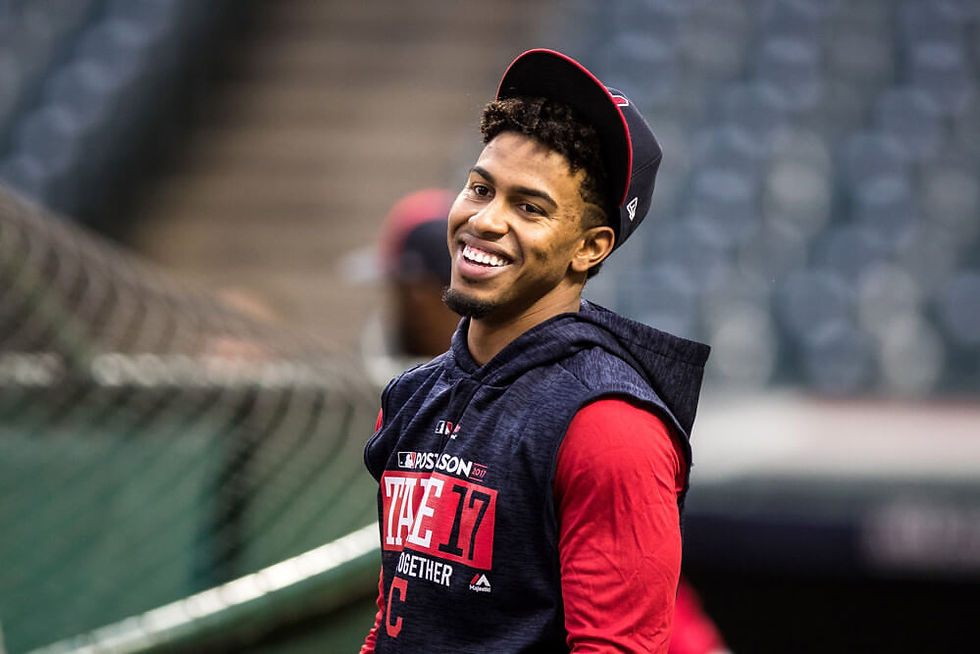Is Francisco Lindor the poster boy of the fly ball revolution?
- Dylan Anderson

- Mar 22, 2018
- 4 min read

By now, most of us have probably heard some rumblings about the “Fly Ball Revolution.” We know that, regardless of whether or not the baseball is juiced (it is), 2017 was the greatest season for power in the history of America’s Pastime™. Last season saw a 50-homer hitter from both leagues for the fourth time ever. It saw the previous record for home runs in a season obliterated.
Some, but not all of the homer spike can be attributed to bouncier balls. Since 2015, MLB has seen a three-year trend in increasing launch angles. Each of these three years set successive records for HR/FB rate for the 16 seasons Fangraphs have batted ball data for. This makes sense. Hitting the ball higher gives it a greater chance to go over the fence, to a certain extent.
The inspiration for this piece was a conversation from the Inside Edge office. A veteran asked, “Is OBP not good anymore?” His question referred to hitters selling out for power. We discussed if losing 20 points of batting average or on-base percentage was worth the thin middle infielder acquiring 25 homer pop. Daniel Murphy comes to mind. He’s a second basemen who finally eclipsed the 25 dinger mark during his age 31 season. We know he made swing adjustments to hit more fly balls and add power to his toolset. But Murphy did not sacrifice his base-reaching skills. His 2016 and 2017 seasons for the Nationals were the two best years of his career for average and OBP.
To find a player to answer my boss’s question, I scrolled down the list of 2017 home run leaders until I found an atypical power hitter. It didn’t take long. Francisco Lindor hit 33 homers last year, good for 21st in MLB, first among shortstops and one behind Brian Dozier for tops by middle infielders, the small, agile glovesmen of the diamond. Lindor stands 5’11 and a defensive wizard at arguably the most important position. The last full time shortstop to hit more was Bill Hall in 2006.
Lindor’s power bump wasn’t just unusual for his size and his position, it was out of line with even the most positive scouting reports of his potential. A top prospect since his teenage years, Lindor received a 40 power grade in an MLB.com report in 2014. He was considered to be the fifth best prospect in baseball despite the expectation that he would never reach even league average in the home run department. Dozens and dozens of the best scouts in the world had seen him.
To begin Lindor’s professional career, the eighth overall pick in the 2011 draft hit 21 big flies in 416 minor league
games. In his first two MLB seasons, Lindor slugged 27 homers in 257 games. Then he hit 33. In 159 games.
So, how did the 190 pound Lindor acquire slugger power in a home ballpark that’s unfavorable to righty power? He vastly changed his approach. But not exactly the way you might think. Many assume that to hit home runs, players need to swing harder and strike out more. This theory may apply to sluggers such as Chris Davis and Aaron Judge. But even in the most prolific strikeout environment in history, Lindor managed a career low 12.9% strikeout rate, equaling his 2016 mark.
Unlike Daniel Murphy, Lindor saw his batting average drop precipitously. This was the result of the switch hitter putting the ball in the air instead of on the ground. Lindor’s batting average on balls in play fell more than 50 points below his previous career mark, likely the result of hitting significantly more pop ups and fly balls, which are less likely to result in a hit but more likely to leave the yard. He also hit fewer line drives, which of course have the highest probability of earning a hit. How Lindor was able to cut his ground ball to fly ball ratio nearly in half is a question only he may be able to answer. How he made such a radical adjustment in a single season from both sides of the plate while maintaining his very low strikeout rate is a testament to how talented and hardworking he is.
So back to the question that got us here, “Is OBP not good anymore?” The short, obvious answer is no. Of course OBP is still good and a hitter’s fundamental purpose is to reach base. But baseball is a nuanced game. In 2016, Lindor slashed .301/.358/.435. Last season he posted .273/.337/.505. On its surface, the value differential of trading 28 points of batting average and 21 points of OBP for 70 points of slugging seems hard to surmise. Luckily, we have compilation metrics that make it simple. Lindor’s wOBA rose from .340 to .353 and his wRC+ went from 111 to 118. Furthermore, Fangraphs’ batting runs above average metric found Lindor to go from 9.0 to 16.2 even in a better home run environment. OBP is still good, and so is power.
Can Lindor repeat or improve upon his 2017? Most projections have him regressing to some degree, with mid 20s homer expectations and on base rates hovering around .350. Lots of smaller guys had breakout power numbers last year. Scooter Gennett hit 29 home runs. Eddie Rosario clubbed 27. The list goes on. It will be fascinating to see if the airborne power trend continues in 2018, and if more players will be able to follow in Lindor’s footsteps.









Comments